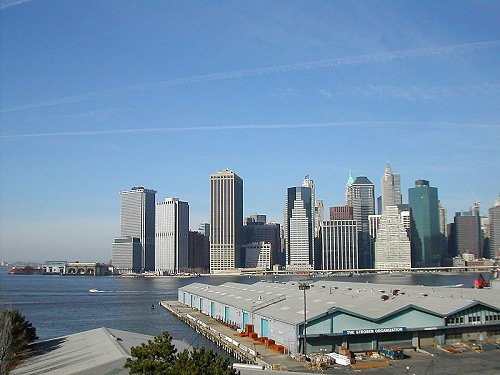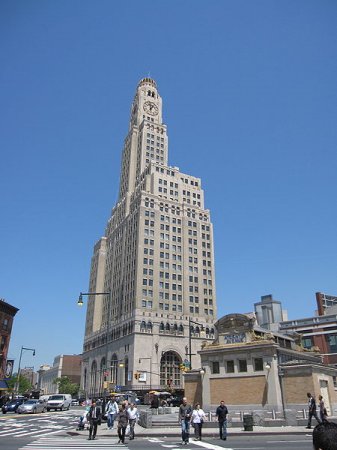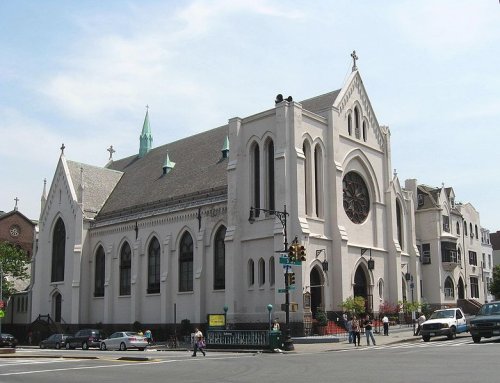 Brooklyn Heights Piers, with views of Manhattan skyline
Brooklyn Heights Piers, with views of Manhattan skylineSource: https://commons.wikimedia.org/wiki/File:Brooklyn_Heights_Promenade.jpg
Author: R.scholz

Brooklyn is the most populous borough of New York City. Located on the westernmost tip of Long Island, it covers 71 sq mi (183 sq km) and has a population of 2.6 million people. It is the most populous borough of New York City and the second most densely populated after Manhattan. If Brooklyn were a separate city, it would be the fourth largest city in the United States.
Brooklyn was indeed an independent city until it was merged with New York City in 1898. The whole of Brooklyn is also within the same boundary as Kings County of New York State. As with Manhattan, Brooklyn has many ethnic neighbourhoods. There are communities of Italians, Russians, Jews, West Indians, and more, each with its own enclave in Brooklyn.
As was the case with Manhattan, Brooklyn was first settled by the Dutch, who established the first settlement there in 1624. Brooklyn got its name from the town of Breukelen, in Utrecht, in the Netherlands. The village of Breuckelen was established in the Brooklyn area - then part of New Netherland - in 1646.
New Netherland was lost by the Dutch to the British in 1664. The British then reorganized the area, now called the Province of New York, into twelve counties, of which one was called Kings County. In the early days, Breuckelen was a village within Kings County, which was named in honor of King Charles II of England. Over time, its name evolved to Brockland, Brocklin, Brookline, Brookland, and eventually Brooklyn.
 Williamsburgh Savings Bank Tower, Brooklyn
Williamsburgh Savings Bank Tower, BrooklynSource: https://commons.wikimedia.org/wiki/File:Williamsburgh_Savings_Bank_Tower_9128.jpg
Author: Gryffindor

The early part of the 19th century saw rapid development along the waterfront of the East River facing Manhattan. Kings County had two main cities, Brooklyn and Williamsburgh. In 1854, Brooklyn annexed Williamsburgh, which thereafter is spelled Williamsburg. In 1894, the people of Brooklyn voted to join Manhattan, The Bronx, Queens and Richmond, to form the five boroughs of New York City. In the next two years, Brooklyn grew to reach the municipal boundaries of Kings County.
Today more than half the population of Brooklyn are actually working in Manhattan. Brooklyn itself receives a spillover of services industries from Manhattan, such as in financial back-office operations. Until the 1970's, manufacturing formed the backbone of the economy, which has since shifted towards services.
 Holy Family and St Thomas Aquinas Church, Brooklyn
Holy Family and St Thomas Aquinas Church, BrooklynSource: https://commons.wikimedia.org/wiki/File:4th_Av_9th_St_BMT_stair_jeh.jpg
Author: Jim.henderson

Visiting Brooklyn
You can reach Brooklyn easily by subway from Manhattan and Queens. Most of the subway lines from Manhattan that continues into Brooklyn stop at the Atlantic Avenue Subway Station, the largest subway station in the network outside Manhattan.If you are going by car or taxi, Manhattan is connected to Brooklyn by the Brooklyn-Battery Tunnel, the Brooklyn Bridge, the Manhattan Bridge and the Williamsburg Brige. Brooklyn is also connected to Staten Island by the Verrazano Narrows Bridge.
Sights in Brooklyn
- Brooklyn Academy of Music
- Brooklyn-Battery Tunnel
- Brooklyn Botanic Garden
- Brooklyn Children's Museum
- Brooklyn Museum
- Coney Island
- Gateway National Recreation Area
- Grand Army Plaza
- Jamaica Bay Wildlife Refuge
- Park Slope Historic District
- Prospect Park
Places in Brooklyn
- Barren Island
- Bath Beach
- Bay Ridge
- Bedford-Stuyvesant
- Bensonhurst
- Bergen Beach
- Boerum Hill
- Borough Park
- Brighton Beach
- Brooklyn Heights
- Brownsville
- Bushwick
- Canarsie
- Carroll Gardens
- Chinatown
- Cobble Hill
- Coney Island
- Clinton Hill
- Crown Heights
- Cypress Hills
- Downtown Brooklyn
- DUMBO
- Dyker Heights
- East Flatbush
- East New York
- Flatlands
- Fort Greene
- Fort Hamilton
- Gerrutseb Beach
- Gravesend
- Greenpoint
- Manhattan Beach
- Marine Park
- Mill Basin
- Red Hook
- Sea Gate
- Sheepshead Bay
- Sunset Park
- Williamsburg
- Windsor Terrace
 Latest updates on Penang Travel Tips
Latest updates on Penang Travel Tips

Copyright © 2003-2025 Timothy Tye. All Rights Reserved.

 Go Back
Go Back